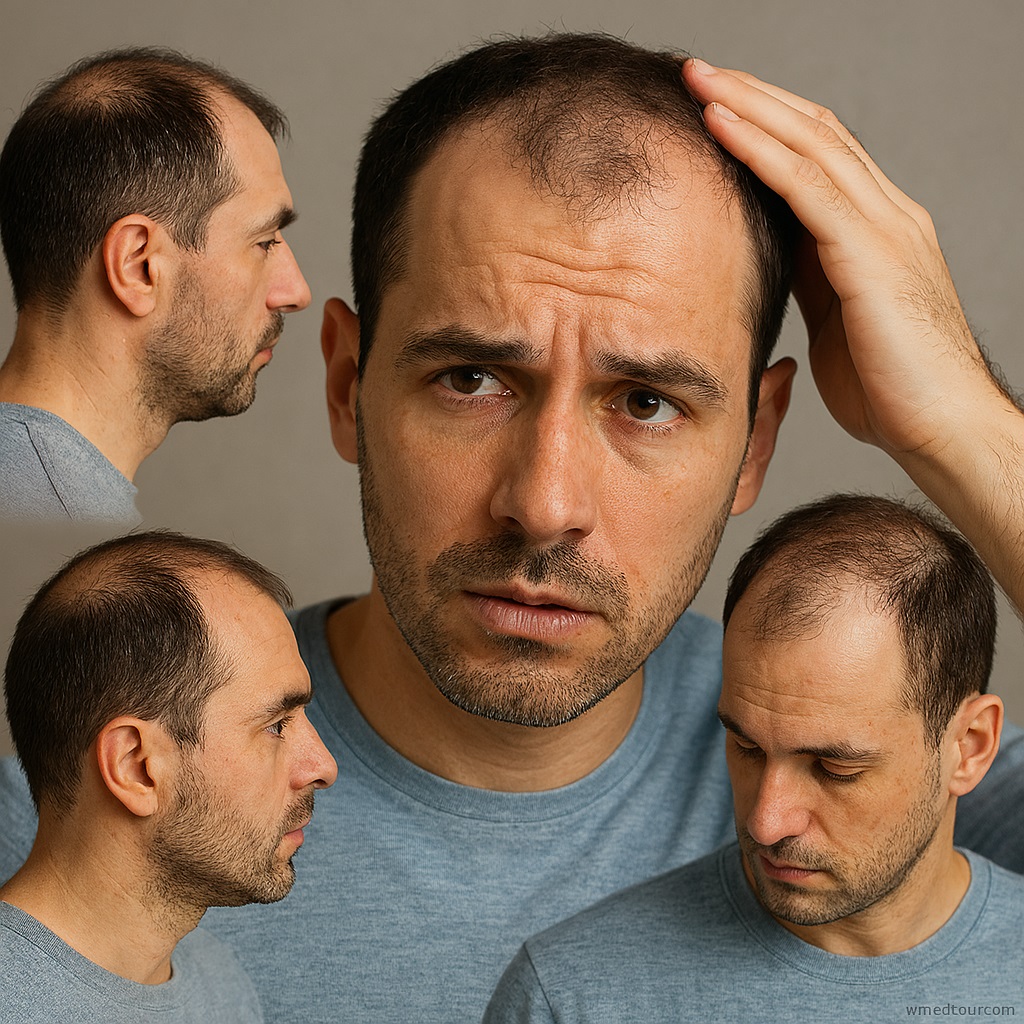The Different Types of Hair Loss Explained: Which One Do You Have?
Hair loss can feel isolating, but you’re far from alone. Understanding the specific type you have is the crucial first step toward effective treatment. In this guide, we break down seven major hair loss categories—covering causes, patterns, and proven therapies—so you can pinpoint your situation and explore the right solutions.
Why Knowing Your Hair Loss Type Matters
Different types of hair loss require tailored approaches. Without an accurate diagnosis, you risk wasted time, money, and even worsening your condition. Whether you’re researching at home or preparing for a consultation with our board-certified specialists, this overview will give you clarity.
Seven Main Types of Hair Loss
1. Androgenetic Alopecia (Pattern Baldness)
This is the most common form, affecting up to 80% of men and 50% of women during their lifetime. It’s genetically driven and linked to DHT sensitivity.
- Men: receding hairline, thinning crown
- Women: diffuse thinning across the top
Learn about our FUE and FUT transplant packages tailored for pattern baldness. NIH Reference
2. Telogen Effluvium
Often triggered by stress, illness, surgery, or childbirth, this type causes excessive shedding. Typically, hair cycles normalize within six months once the trigger is managed.
3. Alopecia Areata
An autoimmune condition where the body attacks its follicles, leading to round, patchy bald spots.
More info: AAD
4. Traction Alopecia
Caused by tight hairstyles—braids, buns, ponytails—that pull on the roots. Early stages reverse with style changes; chronic tension may require transplant.
Prevention tips: Hair loss prevention
5. Scarring Alopecia (Cicatricial)
Inflammation destroys follicles, replacing them with scar tissue. This permanent type can stem from conditions like lichen planopilaris or lupus.
External: NIAMS
6. Anagen Effluvium
Rapid loss during the growth phase, typically due to chemotherapy, radiation, or toxins. Regrowth often occurs post-treatment.
Source: American Cancer Society
7. Nutritional Deficiency Hair Loss
Deficiencies in iron, zinc, protein, or vitamin D can weaken follicles and trigger shedding.
Diet tips: Nutrition guide
Comparison Table: Types of Hair Loss
| Type | Cause | Pattern | Reversible? |
|---|---|---|---|
| Androgenetic Alopecia | Genetic, hormonal | Receding/ diffuse thinning | No (manageable) |
| Telogen Effluvium | Stress, shock | Diffuse shedding | Yes |
| Alopecia Areata | Autoimmune | Patchy spots | Often |
| Traction Alopecia | Tension from styling | Frontal/temple thinning | Early only |
| Scarring Alopecia | Inflammation | Permanent patches | No |
| Anagen Effluvium | Chemotherapy | Rapid loss | Yes |
| Nutrition Deficiency | Lack of nutrients | Diffuse thinning | Yes |
How to Get a Professional Diagnosis
Early diagnosis with trichoscopy, blood tests, and a scalp biopsy ensures targeted treatment. Our free virtual consultations with specialists help international patients plan travel and care.
Frequently Asked Questions
1. What’s the most common form of hair loss?
Androgenetic alopecia accounts for most cases globally.
2. Can women suffer from pattern baldness?
Yes, though it appears as overall thinning instead of distinct bald spots.
3. Does stress really cause hair loss?
Yes, stress can trigger telogen effluvium within 2–3 months.
4. Is alopecia areata permanent?
Not always—hair often regrows, but relapse is common.
5. How can I prevent traction alopecia?
Avoid tight hairstyles and regularly change your styling routine.
6. Can scarring alopecia be treated?
It’s permanent, but early anti-inflammatory treatment can slow progression.
7. Will hair grow back after chemo?
Yes, typically within 3–6 months post-treatment.
8. Which nutrients are vital for hair health?
Iron, zinc, proteins, and vitamins A, D, E, B-complex.
9. What’s the role of DHT in hair loss?
DHT shrinks follicles in genetically sensitive people, leading to pattern baldness.
10. Can diet alone reverse hair loss?
Only nutritional deficiency–related loss; other types need medical intervention.
11. Are natural remedies effective?
They may support general scalp health but rarely address root causes alone.
12. When should I see a dermatologist?
If you notice sudden shedding, patchy spots, or scarring in the first stages.
13. Are hair transplants safe?
Yes, when performed by board-certified surgeons using proven techniques.
14. How long does a transplant take to show results?
Initial growth appears at 3–4 months, with full results by 12–18 months.
15. What’s PRP therapy?
Platelet-rich plasma uses your blood’s growth factors to stimulate follicles.
16. Can teenagers experience pattern baldness?
Yes, early-onset pattern baldness can appear post-puberty in genetically predisposed teens.
17. Is laser therapy effective?
Low-level laser therapy can thicken hair and reduce shedding in some types.
18. Do medications help?
FDA-approved options like finasteride and minoxidil are effective for many.
19. What’s the cost range for treatments?
Non-surgical treatments: $20–100/month; transplants: $3,000–15,000 depending on grafts.
20. How do I choose the right clinic?
Look for board certification, before/after galleries, and transparent pricing.
Ready to identify your hair loss type and start an effective treatment plan? Book your free consultation now and regain your confidence.




